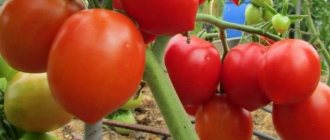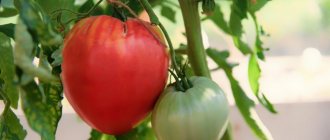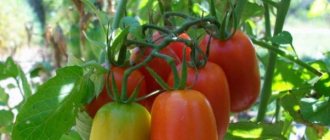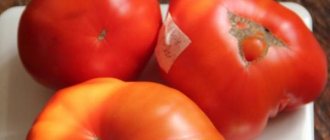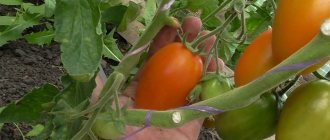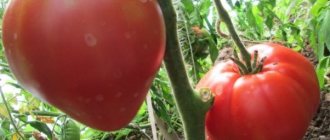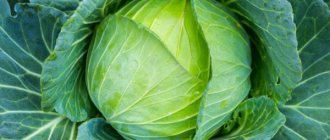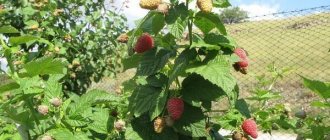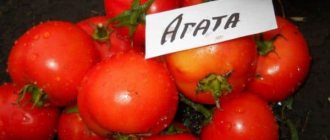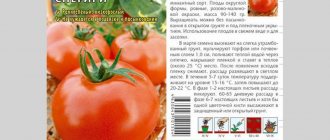Vegetable growing » Tomatoes
0
2626
Article rating
Kira Stoletova
The Rhapsody tomato is a new and interesting plant species of the northern type, which was bred using hybridization. The initial idea was to create a type of tomato that could produce an increased yield in greenhouses. And the breeders succeeded.
Description of tomato Rhapsody
Briefly about the hybrid
- Fruits and bush: tall cluster type, height up to 2 m, fruit color red, weight 120-140 g.
- Productivity: up to 20-40 kg/1 m².
- Resistance: good immunity to fusarium, brown spot, verticillium, tobacco mosaic, and short-term temperature drops.
- Distribution: recommended for growing in greenhouses and open ground (in warm regions).
- Application: universal.
- Planting: planting by seedlings is preferred.
- Soil: loose, nutritious, neutral acidity.
- Care: requires mandatory pinching and shaping; due to the height of the shoots, it needs high supports and garter.
- Ripening period: 100-120 days after emergence.
- Fruiting period: from July until the first autumn frosts.
Recommendations for cultivation
Reviews from experienced gardeners say that if you sow the seeds of Raspberry Rhapsody into seedlings in a timely manner, you can harvest the first ripe fruits at the earliest date. It is best to do this at the end of March or early April. It is not recommended to plant seeds before this time, since the seedlings will grow quickly, and due to the fact that the spring frosts have not yet subsided, it will be impossible to climb into the garden. It is advisable to transfer seedlings to open ground no earlier than in early June, when the frost in the mornings has finally subsided.
Tomato bushes of this variety are low-growing, and despite this, they still need to be tied up. The stem of the plant is not strong enough, for this reason gusty winds can tarnish the reputation of the plantings.
It should be said that to grow such tomatoes, you need to think about timely feeding. Throughout the entire growth of the plant, as well as the formation of fruits, fertilizers must be applied at least five times.
Important! This vegetable crop is demanding on the composition of the soil, and produces a large contingent of tasty fruits only when it is provided with first-class care. This tomato variety is resistant to common diseases and pests of nightshade crops
However, blossom end rot can harm the crop. To avoid the occurrence of such problems, it is necessary to reduce the nitrogen content in the soil, increasing the amount of calcium
This tomato variety is resistant to common diseases and pests of nightshade crops. However, blossom end rot can harm the crop. To avoid the occurrence of such problems, it is necessary to reduce the nitrogen content in the soil, increasing the amount of calcium.
The development of brown spot can be prevented by regularly ventilating the greenhouse, and in addition by regularly watering the plantings. High humidity can lead not only to the appearance of a disease, but also to the fact that the roots will rot and the plant will die.
Tomatoes of this variety need attention and certain conditions. So, if you strictly follow simple growing recommendations and take preventive measures against major diseases, you can get a large volume of tasty and aromatic fruits, which means that the gardener’s time and effort will be wasted.
Detailed characteristics
Rhapsody tomatoes have an early ripening period - they usually take about 100 days. Average yields are 8-12 kg/1 bush, or up to 30-40 kg/m² when planting up to 3-4 plants.
The hybrid is most successfully grown in the southern regions. When cultivating in northern regions, planting in greenhouses is recommended.
External description
The plant is tall, bush type. Height when planted in open ground - up to 2-2.5 m, in a greenhouse - up to 3-3.5 m. Length of internodes - up to 12-15 cm, on a fruit cluster - 7-8 fruits, number of clusters - 8- 10.
The inflorescences are simple, laid on 9-1 leaves, subsequent ones with an interval of 3 leaves.
Fruits weigh 120-140 g, round and flattened shape, the peel is loose, thin, but not prone to cracking, the color at the stage of consumer maturity is bright red, the number of seed chambers is up to 3-4, the number of seeds is insignificant.
Taste
The pulp is fleshy and juicy. Tomatoes have a sour taste. The main purpose is to be consumed fresh, in the preparation of first and second courses, and in the production of juices and sauces. Suitable for whole-fruit canning.
Advantages and disadvantages
| pros | Minuses | |
|
| |
Positive aspects of the variety
Like any variety, Rhapsody has its advantages. The positive aspects outweigh any disadvantages of this type of tomato. Let's look at them in more detail:
- all fruits that grow and ripen have pleasant taste characteristics: you can notice an excellent balance between slight sourness, bitterness and sweetness of the product;
- quite attractive appearance, which increases the percentage of vegetable sales;
- An important advantage of Rhapsody is that it has a high percentage of tomato yield and harvest;
- thanks to the hybridization process, this tomato has good resistance to various diseases and almost never gets sick: one bush can live for a long time in the right greenhouse conditions;
- a good percentage of amicable ovary and characteristics of the maturity of all fruits;
- high percentage of all varietal properties.
Read also: Robust tomato characteristics and description of the variety
The plant is highly resistant to diseases
It should be noted that the system has a fairly strong and persistent immunity, a rather interesting and curious taste of the fruit, and excellent friendly ripening. Many farmers praise this variety for its good resistance to various diseases.
Negative points
The disadvantages of this variety include the fact that it is very poorly stored and can begin to rot after just a few weeks. Sometimes situations were noticed that after just a few days the tomatoes became unusable, and nothing could be done with them.
In addition, sometimes the variety can be capricious. He may not like the composition of the soil and fertilizers that are used. Then it stops growing (if it is a young bush), and if not, then an adult bush can either give a small percentage of the yield, or even wither and cannot be rehabilitated in any way.
Features of agricultural technology
The most preferred growing method is seedlings. Sowing of seeds is planned 50-60 days before the expected date of moving to the greenhouse or garden bed.
Soil and seed preparation
Seed material is sown in a disinfected substrate. Before sowing, the seeds are soaked in warm water 0.5 with the addition of ash (2 tbsp/1 l) or a growth biostimulator, dried naturally and hardened in the refrigerator for a week, changing the temperature every 12 hours from 0°C to 20°C С-22°С and vice versa.
For growing tomato seedlings Rhapsody NK f1, a mixture of garden soil, humus, peat and sand, taken in equal proportions, is suitable.
Sowing technology
Containers 12-14 cm high are filled with substrate, leaving 5-7 cm to the edges. Seeds are sown in 1-2 pieces, buried at a distance of 1.5-2 cm, sprinkled with soil on top and covered with polyethylene to create a greenhouse effect.
Care
Until the seedlings germinate, the crops are kept at a temperature of 22°C-24°C. With the emergence of seedlings (approximately 7 days after planting), the containers are transferred to a cool place where the temperature is maintained at 18°C-19°C, and the covering polyethylene is removed.
Watering is carried out by spraying from a spray bottle as the top layer of the substrate dries.
Picking
The seedlings peak with the appearance of 3-4 leaves. The seedlings are transplanted into individual containers with a volume of 0.5 liters, deepened by 5-7 cm, and placed in a well-lit place under diffused light.
If there is insufficient lighting, additional lighting is provided. The total required daylight hours are at least 13-15 hours.
Growing conditions
The Raspberry Paradise variety, like the Raspberry Zvon tomato, is recommended to be planted by seedlings. The first step is to prepare the materials for sowing.
Step-by-step description of sowing work:
- Before sowing, the seeds are soaked in a growth stimulator.
- The soil is prepared using garden soil and humus. If there is no humus, it can be replaced with peat.
- If a summer resident needs to plant a plant in open ground, sowing work should be carried out in the second half of March.
- Seeds are planted in peat containers, which avoid the picking process, which injures the weak roots of the seedlings.
In order for the Raspberry Paradise seeds to germinate quickly, they should be placed in an environment with moderate humidity and a temperature of 23 - 25 degrees.
The description of the variety recommends caring for and replanting seedlings according to the following instructions:
- Pots with seedlings are placed in the light and watered with water using a spray bottle or watering can.
- After 50 days have passed since the emergence of seedlings, the plants should begin to be hardened off. To do this, you need to take the seedlings out into the open air every day. The duration of the hardening procedure should be about 2 hours.
- The description of tomatoes recommends planting the plant in open ground in early June. If planting will be carried out in a greenhouse, you can start dacha work in the second half of May. Before planting, make sure that the soil is completely warmed up.
- Holes are formed for replanting, and the soil in them is fertilized with humus.
- Raspberry Paradise seedlings are placed in the formed depression along with a peat container in which the seeds were sown, lightly sprinkled with soil and watered with heated water. Future bushes are placed at a distance of 60 - 70 centimeters from each other.
Before transplanting seedlings into the soil, they should be fed twice with complex fertilizer.
To obtain maximum yield, it is necessary to care for planted tomatoes:
- immediately after the process of transplanting Raspberry Paradise seedlings, it should be tied to supporting structures;
- after the first fruits appear, the bunches of tomatoes should be strengthened by tying them to supporting structures - otherwise the branches may break under the mass of ripe, bright crimson tomatoes;
- the bush must be formed into one stem, and all additional side shoots above the 3rd cluster must be removed in a timely manner;
- During 1 season, it is necessary to feed the planting 4 times, using liquid complex fertilizers.
Compliance with all the listed rules will protect Raspberry Paradise from damage to the branches and get a rich harvest of delicious tomatoes. Moreover, if proper care is provided, the plant will have good immunity to common tomato diseases.
Transplanting seedlings
The seedlings are transplanted when at least 5-6 leaves appear on them:
- in the southern regions in greenhouses - in late April-early May, in open ground - in May;
- in the northern regions - in June.
A prerequisite for planting on open ridges is to warm the soil to 10°C-15°C to a depth of about 10 cm and set the daytime ambient air levels at 16°C-18°C, and at night – not lower than 10°C.
Nutritious, loose soil with good moisture absorption and breathability, neutral acidity, is suitable for planting the variety. The most suitable place is an area well illuminated by sunlight. Before planting seedlings, humus (5 kg), superphosphate (40 g), potassium salt (20 g) and wood ash (1-2 kg) are added to the beds.
Scheme:
- within 2 weeks, the seedlings begin to harden, taking them to a cool place;
- holes are dug about 15 cm deep;
- the optimal distance between bushes is 0.5-0.6 m, between rows - 0.5-0.7 m.
Transplanted seedlings are watered with 1 liter under each bush and sprinkled with soil after final absorption of water, the root zone is mulched.
Care
Tomatoes are watered at the root, avoiding water getting on the foliage and stems. Consumption rate - 7-10 l/1 bush. Frequency: once every 7-14 days, depending on weather conditions. Watering is stopped 2-3 weeks before harvest.
The root area is loosened after watering. Loosening depth - up to 5 cm.
The feeding rules are described in the table:
| Deadlines | Type of feeding |
| Immediately at the time of planting in previously unfertilized soil | Humus. In dry form - 10 cm thick. In liquid form - 0.5 kg / 5 l of water, water the planting holes with 2-3 l. |
| 2 weeks after landing | Mullein (0.5 kg) and superphosphate (10 g). The consumption rate of working fluid is 0.5 l per bush. |
| In 3 weeks. Repeat at the stage of ovary formation and fruit formation with low yields and pale foliage color. | Along with hilling, they dig up a dry mixture of superphosphate (20 g), potassium salt (15 g), ammonium nitrate (10 g). Consumption rate – per m². |
Tomatoes Rhapsody NK f1 require mandatory shaping and pinching:
- the bush is formed into 1-2 stems;
- the stepsons break off, leaving stumps of 1.5 cm;
- When the height reaches 2 m, the tops are pinched.
High yields from the hybrid can be expected when grown in greenhouses with a trellis garter.
They begin tying up bushes under 2-4 leaves. To ensure free passage of air flow and access to sunlight, as the fruit clusters grow, all foliage underneath them is removed.
How to grow tomatoes
The stage of caring for plants after seedlings is no less important. Let's look at what you should pay special attention to.
Landing
Sprouts should be replanted with a lump of earth on the roots. The required distance between the beds is about 40 cm. It is better to plant bushes in cool, windless weather. Immediately after planting, it is recommended to water the tomatoes generously with warm water.
Please note that the soil should be free of pests and fungal pathogens or infections. The best predecessors for tomatoes are cucumbers, cabbage, and potatoes. The hybrid likes the presence of sand or ash in the ground.
Read also: What does orchids in a dream mean?
Both an experienced gardener and a novice gardener can properly care for tomatoes. The main thing is to water the beds on time and remove weeds. Be careful with water: its excess leads to the development of fungus. It is also necessary to periodically loosen the soil - this saturates it with air.
Since Rhapsody is an indeterminate variety, a mandatory garter is required. The tomato forms many stepsons - they slow down the development of the bush and take away nutrients, so they should be removed in time. The bushes form either one or two stems.
Important ! Nitrogen-containing fertilizers have a positive effect on the development of Rhapsody. However, be careful with them - an excess is fraught with illness. The most popular remedies are ammonium nitrate, bone meal and potassium salt.
Features of cultivation and possible difficulties
Particular attention should be paid to the removal of stepchildren. Excess shoots lead to a decrease in yield. Rhapsody's stepsons appear already at the seedling stage. Their removal is a rather labor-intensive process that requires additional time and effort. After planting in the ground, it is recommended to remove shoots every 6-7 days. Stepchildren should be removed with gloves.
Also pay attention to disease prevention. Rhapsody does not have 100% immunity to fungi and infections. To protect tomatoes from them, it is advisable to carry out preventive measures. For example, spray the bushes with nettle infusion or fertilize the soil with nutrients.
Diseases and pests
Even if all the rules are followed, the tomato can get sick. The most common crop disease is late blight. Occurs due to high humidity and excess nitrogen. Signs of late blight are brown spots and white coating on the leaves.
It is difficult to get rid of fungus; sometimes the only way out is to remove the infected bushes. Along with late blight, tomatoes can get tobacco mosaic or powdery mildew. Professional medications or folk recipes can cope with these diseases. For example, a tincture of garlic and ash.
Also, tomatoes are not immune to pests. The most common are: spider mites, whiteflies, mole crickets, and wireworms. These insects take nutrients from the plant, as a result of which the plant dies. To prevent this, weeds should be removed and bushes should be treated with special preparations. For example, with Medvetox or Tzipi.
Diseases and pests
Rhapsody is well resistant to infections. As a preventive measure, folk remedies are used - spraying with soda (200 g/1 l of water) or a milk solution (0.5 l of whey/10 l of water).
It is recommended to carry out preventive treatments for any varieties and hybrids of tomatoes three times during the growing season.
More often than not, hybrid tomatoes are not susceptible to attack by pests, but slugs may appear on the bushes. They are used against them by dusting the soil with wood ash, collecting insects by hand and setting traps.
